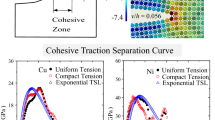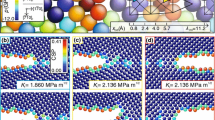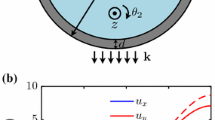Abstract
The Pu-He pair potential fitted by ab initio data, and the Pu-Pu and He-He modified embedded atom method (MEAM) potentials have been implemented to perform multi-scale simulations for the interactions of fracture with the self-interstitial atom (SIA), He interstitial atom and He-vacancy clusters. The simulation results indicate that Pu atoms around the fracture agglomerate into an elliptic self-interstitial loop. Interstitial He atoms evolve into separate interstitial atoms, small He atom clusters and some substitutional He atoms. The He-vacancy cluster forms a spheric structure with a 1:1 He-to-vacancy ratio. Finally, the existence of self-interstitial atoms will lead to the local change of Pu lattice and an increasing disorder, and the whole simulation cell shows a melting state at about 10.0 ps.
Similar content being viewed by others
References
Baclet N, Oudot B, Grynszpan R, et al. Self-irradiation effects in plutonium alloys. J Alloys Compd, 2007, 444–445: 305–309
Siegfried S H. Plutonium-an element never at equilibrium. Met Trans A, 2008, 39: 1585–1592
Ao B Y, Wang X L, Hu W Y, et al. Atomistic study of small helium bubbles in plutonium. J Alloys Compd, 2007, 444–445: 300–304
Wolfer W G, Oudot B, Baclet N. Reversible expansion of gallium-stabilized δ-plutonium. J Nucl Mater, 2006, 359: 185–191
Caturla M J, Diaz de la Rubia T, Fluss M. Modeling microstructure evolution of f.c.c. metals under irradiation in the presence of He. J Nucl Mater, 2003, 323: 163–168
Chung B W, Thompson S R, Lema K E, et al. Evolving density and static mechanical properties in plutonium from self-irradiation. J Nucl Mater, 2009, 385: 91–94
Chung B W, Thompson S R, Woods C H, et al. Density changes in plutonium observed from accelerated aging using Pu-238 enrichment. J Nucl Mater, 2006, 355: 142–149
Robinson M, Kenny S D, Smith R, et al. Simulating radiation damage in δ-plutonium. Nucl Instrum Meth B, 2009, 267: 2967–2970
Wolfer W G, Kubota A, Söderlind P, et al. Density changes in Ga-stabilized δ-Pu, and what they mean. J Alloys Compd, 2007, 444–445: 72–79
Schwartz A J. Plutonium metallurgy: The materials science challenges bridging condensed-matter physics and chemistry. J Alloys Compd, 2007, 444–445: 4–10
Freibert F J, Dooley D E, Miller D A. Formation and recovery of irradiation and mechanical damage in stabilized δ-plutonium alloys. J Alloys Compd, 2007, 444–445: 320–324
Ravat B, Oudot B, Baclet N. Study by XRD of the lattice swelling of PuGa alloys induced by self-irradiation. J Nucl Mater, 2007, 366: 288–296
Wolfer W G, Söderlind P, Landa A. Volume changes in δ-plutonium from helium and other decay products. J Nucl Mater, 2006, 355: 21–29
Fluss M J, Wirth B D, Wall M, et al. Temperature-dependent defect properties from ion-irradiation in Pu(Ga). J Alloys Compd, 2004, 368: 62–74
Harbur D R. The effect of pressure on phase-stability in the Pu-Ga alloy system. J Alloys Compd, 2007, 444–445: 249–256
Pochet P. Modeling of aging in plutonium by molecular dynamics. Nucl Instr Meth B, 2003, 202: 82–87
Valone S M, Baskes M I, Stan M, et al. Simulations of low energy cascades in fcc Pu metal at 300 K and constant volume. J Nucl Mater, 2004, 324: 41–51
Jomard G, Berlu L, Rosa G, et al. Computer simulation study of self irradiation in plutonium. J Alloys Compd, 2007, 444–445: 310–313
Berlu L, Jomard G, Rosa G, et al. A plutonium δ-decay defects production study through displacement cascade simulations with MEAM potential. J Nucl Mater, 2008, 374: 344–353
Samarin S I, Dremov V V. A hybrid model of primary radiation damage in crystals. J Nucl Mater, 2009, 385: 83–87
Uberuaga B P, Valone S M. Simulations of vacancy cluster behavior in δ-Pu. J Nucl Mater, 2008, 375: 144–150
Uberuaga B P, Valone S M, Baskes M I. Accelerated dynamics study of vacancy mobility in δ-plutonium. J Alloys Compd, 2007, 444–445: 314–319
Valone S M, Baskes M I, Martin R L. Atomistic model of helium bubbles in gallium-stabilized plutonium alloys. Phys Rev B, 2006, 73: 214209
Wheeler D W, Bayer P D. Evaluation of the nucleation and growth of helium bubbles in aged plutonium. J Alloys Compd, 2007, 444–445: 212–216
Baskes M I. Atomistic model of plutonium. Phys Rev B, 2000, 62: 15532–15537
Baskes M I. Modified embedded-atom potentials for cubic materials and impurities. Phys Rev B, 1992, 46: 2727–2742
Daw M S, Baskes M I. Semiempirical, quantum mechanical calculation of hydrogen embrittlement in metals. Phys Rev Lett, 1983, 50: 1285–1288
Daw M S, Baskes M I. Embedded-atom method: Derivation and application to impurities, surface, and other defects in metals. Phys Rev B, 1984, 29: 6443–6453
Jelinek B, Houze J, Kim S, et al. Modified embedded-atom method interatomic potentials for the Mg-Al alloy system. Phys Rev B, 2007, 75: 054106
Fynn R A, Ray A K. Ab initio full-potential fully relativistic study of atomic carbon, nitrogen, and oxygen chemisorption on the (111) surface of δ-Pu. Phys Rev B, 2007, 75: 195112
Sun B, Zhang P, Zhao X G. First-principles local density approximation+ U and generalized gradient approximation+U study of plutonium oxides. J Chem Phys, 2008, 128: 084705
Jomard G, Amadon B, Bottin F. Structural, thermodynamic, and electronic properties of plutonium oxides from first principles. Phys Rev B, 2008, 78: 075125
Savrasov S Y, Kotliar G. Ground-state theory of δ-Pu. Phys Rev Lett, 2000, 84: 3670–3673
Bouchet J, Albers R C, Jomard G. GGA and LDA+U calculations of Pu phases. J Alloys Compd, 2007, 444–445: 246–248
Wang Y, Sun Y. First-principles thermodynamic calculations for δ-Pu and ɛ-Pu. J Phys-Condens Matter, 2000, 12: L311–L316
Landa A, Sadigh B. Density-functional investigation of magnetism in δ-Pu. Phys Rev B, 2002, 66: 205109
Kollar J, Vitos L, Skriver H L. Anomalous atomic volume of α-Pu. Phys Rev B, 1997, 55: 15353–15355
Hay P J, Martin R L. Theoretical studies of the structures and vibrational frequencies of actinide compounds using relativistic effective core potentials with Hartree-Fock and density functional methods: UF6 and PuF6. J Chem Phys, 1998, 109: 3875–3881
Baskes M I, Muralidharan K, Stan M, et al. Using the modified embedded-atom method to calculate the properties of Pu-Ga alloys. JOM, 55: 41–50
Frisch M J, Trucks G W, Schlegel H B, et al. Gaussian 09w. Pittsburgh PA: Gaussian, Inc., 2009
Berlu L, Jomard G, Rosa G, et al. Computer simulation of point defects in plutonium using MEAM potentials. J Nucl Mater, 2008, 372: 171–176
Wolfer W G. Radiation effects in plutonium. Los Alamos Sci, 2000, 26: 274–285
Author information
Authors and Affiliations
Corresponding author
Rights and permissions
About this article
Cite this article
Li, R., He, B. & Zhang, Q. Atomistic simulation of interactions of fracture with defect clusters in delta-Pu. Sci. China Phys. Mech. Astron. 54, 1805 (2011). https://doi.org/10.1007/s11433-011-4466-y
Received:
Accepted:
Published:
DOI: https://doi.org/10.1007/s11433-011-4466-y




